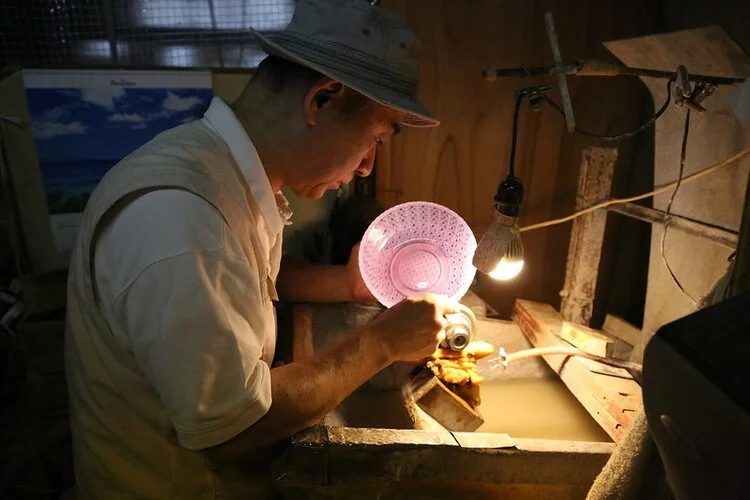Master Kawasaki flattening a piece of steel. ©Kaoruko Hanawa
akihira kawasaki - master japanese swordsmith
An Art Form Best Appreciated in Light
“Swords are often thought of as weapons, but that’s only one aspect. Their true allure lies in their nature as works of art – objects to be appreciated through light.”
So says master swordsmith Akihira Kawasaki, a successor to the Sōshū Tradition. Kawasaki is one of only six master katana swordsmiths in Japan and the only one based in Kanto.
Dominant in the Kamakura Period (1185-1333) amid metallurgical innovations, Sōshū (相州) (“Sagami Province”) Tradition unifies and layers steel to create iconic patterns and bold temper lines. In combining different steel types, the Sōshū Tradition is the most advanced of the Five Great Traditions in Japanese sword-making. The tradition flourished under legendary swordsmith Masamune Gorō Nyūdō (c. 1264-1343), forging Japan’s most battle-ready and sought-after blades.
As with the famed Masamune blades, Kawasaki’s swords serve important artistic and social roles beyond warfare. Complex purification, heating, and shaping techniques create durable status symbols fit for samurai and shoguns. Like the union of steel types in Sōshū Tradition, Kawasaki advances the forge-fires of cultural legacy: a union of mythology and history in traditional craftsmanship.
“A Japanese sword is all about its form,” states Kawasaki. A truly beautiful sword is a harmony of design: the bold visual effects in hamon (刃文) (“temper line”), the refined steel-layered surface in jihada (地肌) (“steel grain pattern”), and the elegant curve of the tip in sugata (姿) (“blade shape”). He believes “a good sword is like the most beautiful woman — graceful, balanced, and captivating.” Only light can capture the nobility of form and the mastery of detail. “Many museum lights are not designed for appreciating swords. To truly see a sword’s beauty, you must hold it upright in your hands and let the light reveal its form.”
Symbol of Japan: Weapon, Status, and Spirituality
With exquisite cutting ability and luminous appearance, a sword is a weapon beyond doubt. But a sword is also strong with meaning. A quality sword was expensive—and thus, an indicator of its owner’s status, wealth, and aesthetic sensibilities. During the feudal Tokugawa Period (1603-1868), rules about sword length had limited wearing katana (long sword) in public to the samurai. Despite being the noble warrior class, most samurai primarily worked as administrators. Long swords’ symbolic weight, therefore, was more about order and power than chaos or struggle.
“A Japanese sword has three dimensions: functionality as a weapon, beauty as an art piece, and significance as a spiritual anchor. These elements coexist within it,” Kawasaki explains. “in fact, swords were not the main weapon on the battlefield. For samurai, horseback riding and archery were far more crucial. The sword’s role was often for self-defense, or as a symbol of spirit and resolve.”
The Rituals of Sword-Viewing
When viewing a Japanese sword, one should remove any metal accessories, including rings, and bow respectfully. “This is a way of showing respect to those who have preserved this art for over a thousand years,” Kawasaki emphasizes. A sword is not merely an instrument for cutting. It is a tangible work of art — one of light and spirit — that embodies beauty, tradition, and reverence.
©Kaoruko Hanawa
“Swords are often thought of as weapons, but that’s only one aspect. Their true allure lies in their nature as works of art – objects to be appreciated through light.”
— Akihira Kawasaki
PURCHASE A CUSTOMIZED SWORD:
For those who are interested in purchasing a katana sword made by Master Kawasaki, please consult with us. We are an official agent, and we work closely with Master Kawasaki. Please note that Master Kawasaki only produces swords through custom orders. For more information, kindly fill in the inquiry form using the following link.
READ OTHER ARTISAN STORIES





